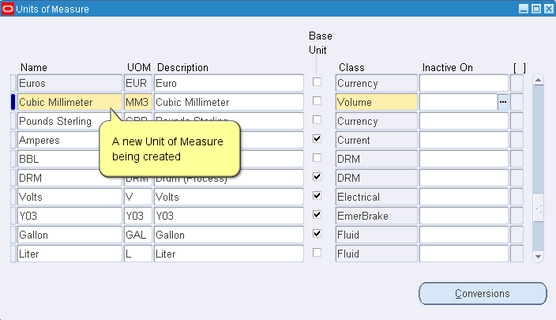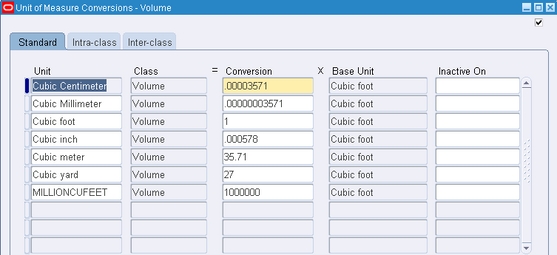About a Unit of Measure
The unit of measure (UOM) helps us count “How much” of an item or “How many” counts of an item is involved in a transaction or is stored in a subinventory and/or locator. This is a simplified definition of UOM (plural: units of measure). For example, when we say we have 10 pencils in a box, we mean there are 10 individual units of pencils in that box. This is usually written in Oracle as 10 Each pencils. Each here is a UOM. Even Box is a UOM.
The next thing to note from the example above is that a UOM needs to be associated with a numerical value to define the quantity. The phrase “pencils in a box” does not qualify anything, not until it is elaborated to “10 pencils in a box”.
FREE Trial Download!
The Start to End Video Guide to Implementing Oracle Inventory in R12
This version will help you explore and review the COMPLETE Video Tutorial... ALL 87 videos, for 1 Trial and 1 Day.
Once you like the Tutorial, select from any of the Subscription options here, to get your copy of the eLearning Video.
FREE Download
Detailed Course Topics for the Start to End VIDEO Tutorial
Unit of Measure Classes
Before we define UOMs, we need to define UOM Classes. UOM classes are used to group together units of measure that have similar characteristics or that measure the same dimension. For example, Length is a UOM Class that typically contains the following UOMs – Centimeter, Meter, Kilometer, Inch, Foot and Mile.
Unit of Measure Conversions
By now, you may be visualizing the need to have conversion factors between these multiple UOMs. For example,
1 Cubic Millimeter = 0.00000003571 Cubic foot
In fact, this is one of the conversions that Office Smart Solutions (OSS) needs to have. So let’s follow Jennifer, the Inventory Lead at OSS as she creates it for them.
A Leaf from the OSS UOM Setup
Office Smart Solutions manufactures its own brand of Ink Cartridges for printers. Based on the business practice at OSS, the ink being filled into these cartridges has to be quantified in cubic millimeters.
Jennifer proceeds to define a unit of measure as shown below.

The UOM Code is set as MM3. This code appears beside the numeric quantity throughout the application.
A unit of measure has to be assigned to a UOM Class. MM3 is assigned to the UOM Class – Volume.
When a UOM Class is defined, the first UOM that is created under that class is called the Base UOM. Every UOM defined subsequently under that UOM Class has to have a conversion defined per unit of the Base UOM.

So, Cubic Millimeter becomes a member of the Volume UOM Class, as shown below.

FREE DEMO: Creating a Unit of Measure in R12
This is a FREE Download for 30 Days.
The demo runs with full functionality, for 30 Days from the Date of first use.
Therefater, download a new copy of the Demo from the same place.
Click anywhere on the picture below to download the DEMO.
If you have any technical issues with downloading this demo, do email us at mywords@oracle-apps-training-online.com.
In this demo, we
- Define a new Unit of Measure (UOM)
- Define a conversion factor for this UOM with reference to the Base UOM in the UOM Class
- Review and confirm that the new UOM and the conversion have been registered by the system
A FREE Video Snippet on UOMs
...from
The Start to End Video Guide to Implementing Oracle Inventory in R12
Something About Intra-class and Inter-class UOM Conversions
Jennifer has a small problem. There is an item called the Linear Hub that has been introduced in the section on Oracle Quality Collection Elements. This item is packed in a way that each box contains 18 units. So, Jennifer needs to define a unit of measure called the Box such that:
1 Box = 18 Each
There are other items at OSS that are packed 8 units in a Box, 12 units in a Box, and the count goes on and on for different items.
So, one size doesn’t fit all!
A situation such as this is accommodated in Oracle using the item-specific Intra-class conversions. This is how it works. Jennifer defines a unit of measure she chooses to call the Variable Box.

Jennifer assigns this UOM to the UOM Class of Quantity, since the UOM Each is the Base UOM for the same class. She then defines an item-specific conversion under Intra-class conversions for the item LH101.

Thus when we need to define an item-specific conversion between units of measure belonging to the same UOM Class, we create an Intra-class conversion
Similarly, when an item-specific conversion is to be defined between units of measures belonging to different UOM Classes, we define an Inter-class conversion. For example a conversion between Pounds and Gallons would necessitate an Inter-class conversion because Pound belongs to the UOM Class of MASS and Gallon belongs to the UOM Class VOL. And this conversion would be item-specific because it is based on the item density.
FREE Trial Download!
Implementing a Multi Org Structure in R12
Next: Building a Shipping Network
Previous: Subinventories for OSS
Return to Oracle Inventory from Unit of Measure







